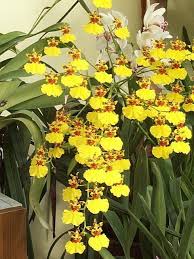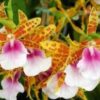# How to Combine Oncidium Orchids with Other Plants in Home Decor

Oncidium orchids, commonly known as Dancing Lady orchids, are admired for their stunning beauty, unique shapes, and vibrant colors. These orchids, with their delicate and intricate blooms, can add elegance and charm to any indoor space. However, to maximize their aesthetic appeal and create a harmonious living environment, it’s essential to understand how to effectively combine them with other plants. This article will explore the various aspects of integrating Oncidium orchids with other houseplants, including tips on plant selection, arrangement techniques, care considerations, and design ideas.
## 1. Understanding Oncidium Orchids
### 1.1 Characteristics of Oncidium Orchids
Oncidium orchids are part of the Orchidaceae family and are known for their distinctive flower shape and long-lasting blooms. The flowers typically have a unique lip that resembles a dancing figure, which is how they got their nickname, “Dancing Lady.” Oncidiums come in various colors, including yellow, orange, white, and purple, making them versatile for different decor styles.
These orchids prefer bright, indirect sunlight and thrive in well-draining potting mediums. Their growth habit can vary, with some species being tall and upright while others may have a more cascading growth form. Understanding the specific needs and characteristics of Oncidium orchids is crucial when planning to pair them with other plants.
### 1.2 Care Requirements
To create a successful indoor plant arrangement, it’s essential to consider the care requirements of Oncidium orchids. They generally prefer:
– **Light:** Bright, indirect light is ideal. Avoid direct sunlight, which can scorch the leaves.
– **Humidity:** Oncidiums thrive in humid environments, ideally between 50% and 70%. Consider using a humidity tray or misting the plants regularly.
– **Watering:** Water when the top inch of the potting medium feels dry, ensuring good drainage to prevent root rot.
– **Temperature:** Ideal temperatures range between 65°F to 75°F (18°C to 24°C) during the day and slightly cooler at night.
## 2. Choosing Companion Plants
When selecting companion plants for Oncidium orchids, it’s essential to choose species that have similar light and humidity requirements. This will ensure that all plants thrive and maintain their health and beauty. Here are some ideal companion plants:
### 2.1 Ferns
Ferns, such as Boston fern (Nephrolepis exaltata) or maidenhair fern (Adiantum), are excellent companions for Oncidium orchids. They thrive in similar humidity levels and provide a lush, green backdrop to the vibrant blooms of the orchids. Their delicate fronds create an attractive contrast to the structured form of Oncidiums.
### 2.2 Peace Lily (Spathiphyllum)
Peace lilies are another great choice, as they thrive in indirect light and enjoy high humidity. Their glossy green leaves and white blooms can complement the colorful flowers of Oncidium orchids. Peace lilies are also known for their air-purifying qualities, adding functional benefits to their aesthetic appeal.
### 2.3 Pothos (Epipremnum aureum)
Pothos is a hardy, low-maintenance plant that thrives in various lighting conditions, making it a versatile choice. Its trailing vines can soften the arrangement and create visual interest when combined with the upright form of Oncidium orchids. Additionally, pothos is an excellent air purifier.
### 2.4 Spider Plant (Chlorophytum comosum)
Spider plants are easy to care for and adaptable, thriving in bright, indirect light. Their arching leaves create a lovely contrast with the vertical growth of Oncidium orchids. Spider plants also produce “baby” plantlets that can be propagated and shared with friends or used to expand your indoor garden.
### 2.5 African Violet (Saintpaulia)
African violets are small, flowering plants that can add a splash of color to your arrangement. They prefer bright, indirect light and moderate humidity, making them a suitable companion for Oncidium orchids. Their round leaves and clusters of colorful flowers create a charming and vibrant display alongside orchids.
### 2.6 Bromeliads
Bromeliads are tropical plants that thrive in bright, indirect light and high humidity. Their unique shapes and colorful inflorescences provide an exciting contrast to the delicate blooms of Oncidium orchids. Additionally, bromeliads can tolerate drier conditions, allowing for some variability in care.
## 3. Arrangement Techniques
Creating a visually appealing arrangement with Oncidium orchids and other companion plants involves thoughtful planning and design. Here are some tips for arranging your plants effectively:
### 3.1 Layering and Height Variation
When arranging plants, consider varying the heights to create a dynamic display. Place taller plants, such as Oncidium orchids, at the back or center of the arrangement, and use shorter plants in the foreground. This layering technique ensures that all plants are visible and contributes to an attractive composition.
### 3.2 Color Coordination
Consider the color palette of your plants when creating an arrangement. Oncidium orchids come in various colors, so choose companion plants that either complement or contrast with these hues. For example, pairing yellow Oncidium orchids with deep green ferns can create a striking visual effect, while purple orchids can be paired with white or cream-colored blooms for an elegant look.
### 3.3 Container Selection
The choice of containers is crucial in enhancing the overall aesthetic of the arrangement. Use pots that complement the colors and textures of the plants. For example, ceramic pots can add a rustic charm, while sleek, modern containers can enhance a contemporary look. Ensure that all containers have proper drainage to support the health of the plants.
### 3.4 Grouping and Symmetry
Arranging plants in groups can create a cohesive look. Consider grouping three or five plants together for a balanced display. Symmetrical arrangements can provide a sense of order and elegance, while asymmetrical arrangements can create a more relaxed and natural appearance.
### 3.5 Incorporating Natural Elements
To enhance the arrangement’s visual appeal, consider incorporating natural elements such as driftwood, stones, or moss. These materials can add texture and interest to the display while emphasizing the natural beauty of the plants. Use these elements sparingly to avoid overwhelming the arrangement.
## 4. Care Considerations
When combining Oncidium orchids with other plants, it’s essential to consider their care requirements and ensure that all plants are thriving in their shared environment.
### 4.1 Watering Practices
Ensure that you understand the watering needs of each plant. While Oncidium orchids prefer to dry out slightly between waterings, companion plants may have different requirements. Use a moisture meter or your finger to check the soil’s moisture level and adjust your watering schedule accordingly.
### 4.2 Humidity Levels
Since Oncidium orchids thrive in high humidity, consider using a humidity tray filled with pebbles and water under the pots. This setup will increase humidity levels around the plants, benefiting all species in the arrangement. Regular misting can also help maintain adequate humidity, especially in drier indoor environments.
### 4.3 Fertilization
Oncidium orchids benefit from regular fertilization during the growing season. Use a balanced orchid fertilizer and follow the manufacturer’s instructions for dilution. Companion plants may have different fertilization needs, so ensure you’re using the appropriate fertilizer for each plant type.
### 4.4 Pest Management
Keep an eye out for pests that may affect your plants. Common pests like aphids, spider mites, and mealybugs can harm Oncidium orchids and their companions. Regularly inspect the plants and use natural pest control methods when necessary, such as insecticidal soap or neem oil, to prevent infestations.
## 5. Creating Different Themes
Combining Oncidium orchids with other plants allows for a variety of design themes to enhance your indoor space. Here are some ideas to inspire your arrangements:
### 5.1 Tropical Paradise Theme
To create a tropical paradise, combine Oncidium orchids with other tropical plants like bromeliads, ferns, and philodendrons. Use vibrant colors and unique textures to create a lush, vibrant display. Incorporate decorative elements like bamboo stakes or tropical-themed pots to enhance the theme.
### 5.2 Elegant Minimalism
For a more minimalist approach, choose Oncidium orchids in white or pastel colors and pair them with sleek, modern containers. Combine them with simple foliage plants like snake plants or ZZ plants. This arrangement will create a serene and elegant atmosphere, emphasizing the beauty of each individual plant.
### 5.3 Rustic Charm
To achieve a rustic charm, opt for terracotta pots and wooden planters. Pair Oncidium orchids with companion plants like ferns and spider plants. Incorporate natural elements such as twigs, stones, or dried flowers to enhance the rustic feel of the arrangement.
### 5.4 Zen Garden
For a calming Zen garden effect, combine Oncidium orchids with succulents and cacti. Use minimalist containers and incorporate sand or gravel as a decorative base. This arrangement creates a tranquil environment that promotes relaxation and mindfulness.
### 5.5 Colorful Celebration
If you want to create a vibrant and cheerful atmosphere, mix Oncidium orchids with colorful flowering plants like African violets and kalanchoe. Use bright, decorative pots to enhance the festive feel. This arrangement is perfect for special occasions and can brighten up any space.
## 6. Conclusion
Combining Oncidium orchids with other plants can elevate your home decor and create a vibrant, harmonious environment. By understanding the characteristics of Oncidium orchids and selecting suitable companion plants, you can create stunning arrangements that enhance the beauty of your living space.
Remember to consider the care requirements
of each plant, arrange them thoughtfully, and choose themes that reflect your personal style. With proper care and attention, your Oncidium orchids and their companions will thrive, providing joy and beauty for years to come.
—

